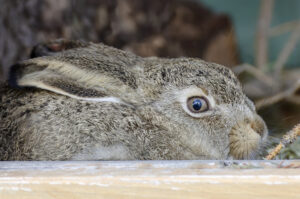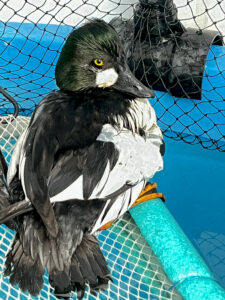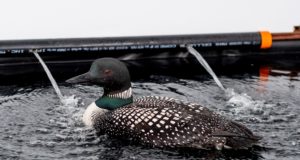By Gabriella Livingstone and Nina Obiar
Climate change is impacting regions and ecosystems across Canada. Recent warming in North America has already led to increased wetland drying and wildfire activity. Forests and wetlands are important ecosystems for Canada’s bird population, providing habitats and key resources. Forests and wetlands, such as the Boreal Forest and the Prairie Pothole Region, are important ecosystems for Canada’s birds and it is, therefore, important to understand the potential ecological impacts of climate change in these regions.
The Boreal Forest is a vast ecosystem that provides a large percentage of North America’s breeding bird habitat and is often called North America’s bird nursery.1 A study from 2020 showed that the Boreal Forest is warming more than twice as fast as the rest of the world and is expected to experience extreme changes to forest composition and structure, negatively impacting bird habitats.2 Alberta’s Prairie Pothole region is another important ecosystem for Alberta’s birds, especially waterfowl, and climate change is likewise posing serious threats to species distribution and specie’s climatic habitat suitability.
Wildfire
With climate change increasing the magnitude and frequency of wildfires, forest productivity and composition are expected to decline as mortality, regeneration, and growth of tree species are directly impacted.3 Wildfire impacts forest composition and structure meaning young forests largely dominated by deciduous trees are expected to increase whereas old, conifer-dominated forests like the Boreal Forest are projected to decrease significantly.4 In Western Canada, increased wildfire activity is likely to transition the Boreal Forest to a prairie ecosystem, leading to a large loss of forested habitat.5
How is this impacting birds in the Boreal Forest?
Climate change has a strong influence on tree species biomass and forest cover.6 Wildfires in the region led to important changes for the boreal bird community, however, changes vary among species and habitat associations.7 Wildfire is beneficial for species associated with treeless habitats and detrimental for species associated with old and mature mixed-wood and coniferous forests with wildfire responsible for close to 50% of decreasing forest-associated species abundance by 2100.8 A study showed that 18 forest- associated species are expected to decline in abundance by more than 25% by 2100 with many of the declining species already at risk such as the Canada warbler.9
Droughts
Droughts, like wildfires, are expected to become more frequent under global climate change. While droughts are only one of the many climatic phenomena impacting birds, studies show that drought can lead to substantial shifts in species abundance and richness.10 Extreme droughts can dramatically alter ecosystem structure through widespread vegetation die-off, decreased insect abundance, and decreased fruit production.11 Responses to droughts, however, vary among species and ecoregions, therefore, we will take a closer look at the Prairie Pothole Region.
What does this mean for Alberta’s Prairie Pothole Region?
The Prairie Pothole Region contains millions of wetlands formed by glaciers and is the most significant waterfowl production region in North America.12 These wetlands are important ecosystems for North America’s waterfowl, however, they are being negatively impacted by extreme and variable climates, especially severe droughts, which pose a threat to long-term productivity and biodiversity. Within the region, evaporation exceeds precipitation, with southeastern Alberta having one of the highest deficits.13 The Prairie Pothole Region is, therefore, expected to continue to experience increased drought conditions causing declines in waterfowl populations.14
Waterfowl population size, nesting tendency, and clutch size are positively related to wetland numbers.15 Declines in the number and distribution of wetlands in this region during breeding season would, therefore, reduce the number of waterfowl that breed there.
Is climate change the only variable impacting birds in these regions?
While wildfires and droughts are posing major threats to ecosystems like the Boreal Forest and the Prairie Pothole Region, the impacts of these extreme climate-induced weather events are exacerbated by anthropogenic pressures. Studies on the Boreal Forest show that while wildfire accounted for most of the area disturbed, disturbances like the expansion of harvesting, forestry, energy, and mineral extraction will transform boreal bird habitats.16 Harvesting, for example, changes forest structure, composition, and age and impacts bird abundance.17
Similarly, in the Prairie Pothole Region, conservation efforts will be challenged by the intensification of agriculture which is a significant factor affecting the distribution, reproductive success, and abundance of waterfowl.18 Land use is important for waterfowl as nesting success is positively related to the amount of grass in the region.19 Agriculture has adversely impacted the Prairie Pothole Region ecologically through habitat destruction and agricultural runoff. Human-related stressors such as land use must, therefore, be taken into consideration with conservation efforts.
Funding for this project was made possible through the University of Calgary’s Office of Sustainability.
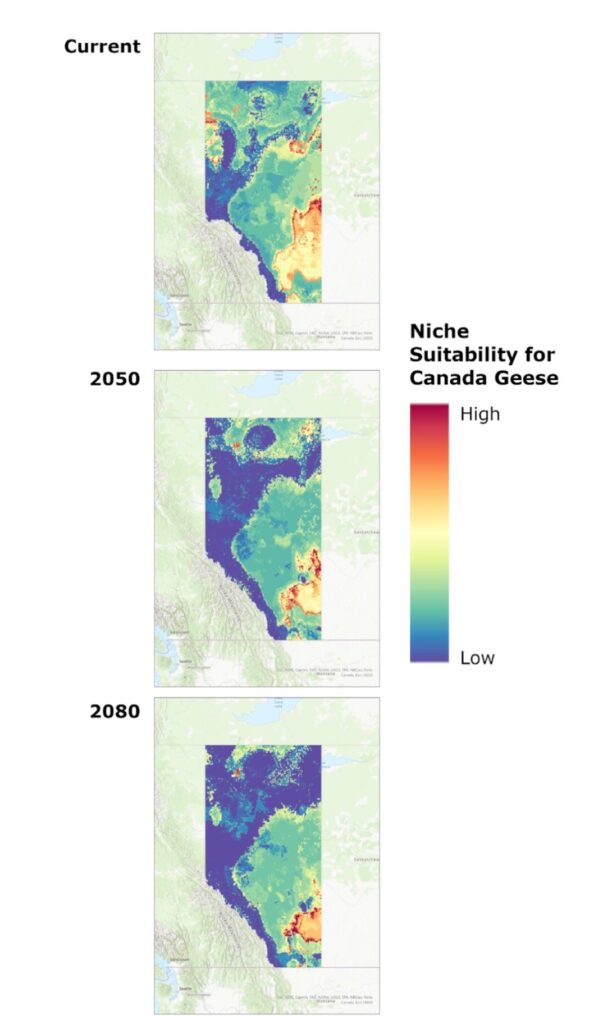
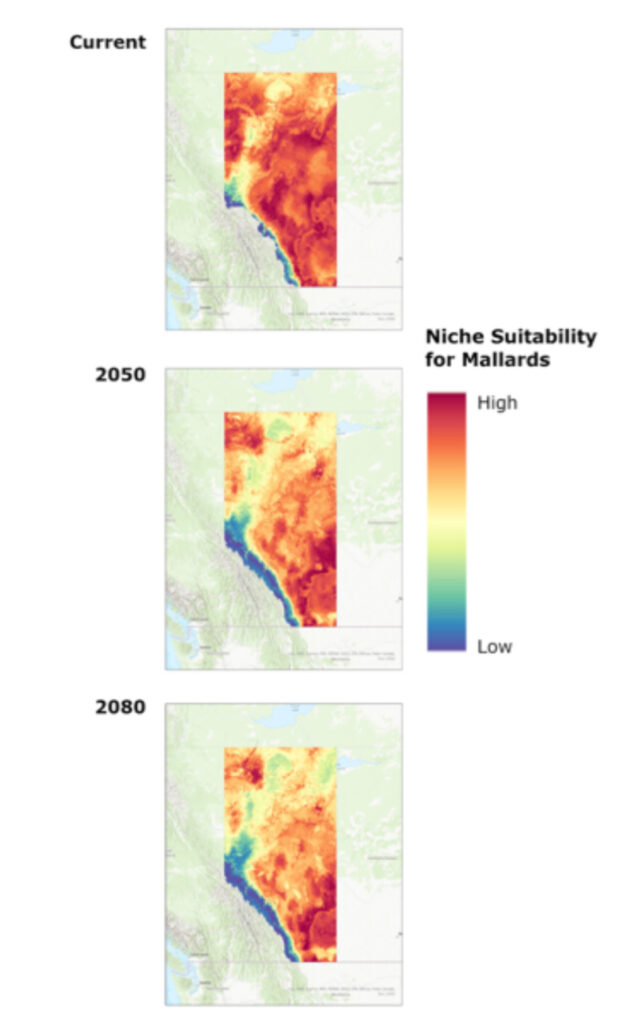
References
- Cadieux, Philippe, Yan Boulanger, Dominic Cyr, Anthony R. Taylor, David T. Price, Péter Sólymos, Diana Stralberg, Han YH Chen, Aaron Brecka, and Junior A. Tremblay. “Projected effects of climate change on boreal bird community accentuated by anthropogenic disturbances in western boreal forest, Canada.” Diversity and Distributions 26, no. 6 (2020): 668-682.
- Philippe, Boulanger, Cyr, Taylor, Price, Sólymos, Stralberg, Chen, Brecka, and Tremblay. “Projected effects of climate change on boreal bird community”
- Philippe, Boulanger, Cyr, Taylor, Price, Sólymos, Stralberg, Chen, Brecka, and Tremblay. “Projected effects of climate change on boreal bird community”
- Philippe, Boulanger, Cyr, Taylor, Price, Sólymos, Stralberg, Chen, Brecka, and Tremblay. “Projected effects of climate change on boreal bird community”
- Philippe, Boulanger, Cyr, Taylor, Price, Sólymos, Stralberg, Chen, Brecka, and Tremblay. “Projected effects of climate change on boreal bird community”
- Philippe, Boulanger, Cyr, Taylor, Price, Sólymos, Stralberg, Chen, Brecka, and Tremblay. “Projected effects of climate change on boreal bird community”
- Philippe, Boulanger, Cyr, Taylor, Price, Sólymos, Stralberg, Chen, Brecka, and Tremblay. “Projected effects of climate change on boreal bird community”
- Philippe, Boulanger, Cyr, Taylor, Price, Sólymos, Stralberg, Chen, Brecka, and Tremblay. “Projected effects of climate change on boreal bird community”
- Philippe, Boulanger, Cyr, Taylor, Price, Sólymos, Stralberg, Chen, Brecka, and Tremblay. “Projected effects of climate change on boreal bird community”
- Albright, Thomas P., Anna M. Pidgeon, Chadwick D. Rittenhouse, Murray K. Clayton, Curtis H. Flather, Patrick D. Culbert, Brian D. Wardlow, and Volker C. Radeloff. “Effects of drought on avian community structure.” Global Change Biology 16, no. 8 (2010): 2158-2170.
- Albright, Pidgeon, Rittenhouse, Clayton, Flather, Culbert, Wardlow, and Radeloff. “Effects of drought”
- McKenna, Owen P., David M. Mushet, Samuel R. Kucia, and Elyssa C. McCulloch‐Huseby. “Limited shifts in the distribution of migratory bird breeding habitat density in response to future changes in climate.” Ecological Applications 31, no. 7 (2021): e02428.
- Niemuth, Neal D., Kathleen K. Fleming, and Ronald E. Reynolds. “Waterfowl conservation in the US Prairie Pothole Region: Confronting the complexities of climate change.” PloS one 9, no. 6 (2014): e100034.
- Niemuth, Fleming, and Reynolds. “Waterfowl conservation”
- Niemuth, Fleming, and Reynolds. “Waterfowl conservation”
- Philippe, Boulanger, Cyr, Taylor, Price, Sólymos, Stralberg, Chen, Brecka, and Tremblay. “Projected effects of climate change on boreal bird community”
- Philippe, Boulanger, Cyr, Taylor, Price, Sólymos, Stralberg, Chen, Brecka, and Tremblay. “Projected effects of climate change on boreal bird community”
- Niemuth, Fleming, and Reynolds. “Waterfowl conservation”
- Niemuth, Fleming, and Reynolds. “Waterfowl conservation”
- Stralberg, D., S. M. Matsuoka, A. Hamann, E. M. Bayne, P. Sólymos, F. K. A. Schmiegelow, X. Wang, S. G. Cumming, and S. J. Song. “Projecting boreal bird responses to climate change: the signal exceeds the noise.” Ecological Applications 25, no. 1 (2015): 52-69.
- Benson, J. (n.d.). Adult Male. Canada Warbler . Retrieved August 8, 2022, from https:// www.audubon.org/field-guide/bird/canada-warbler.

